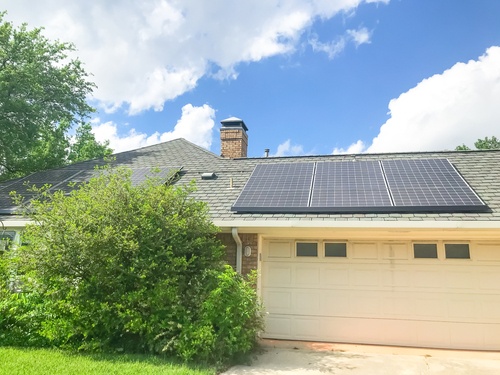Texas is the second-biggest state in the nation with nearly 28 million people, and it's been among the top 10 solar states since 2017. The number of houses in Texas powered by solar photovoltaic (PV) systems approached 225,726, using a total solar investment of $3,223.34 million.
With 1,200 towns in Texas, the five most significant each has over 800,000 citizens who frequently see solar energy as an advantage. Solar prices also have dropped by 53% in the previous five years decades, making the installation of PV systems less expensive.
How Much Do Solar Panel Systems Cost Across The Main Cities In Texas?
Solar system cost in the five largest cities of Houston, Austin, Dallas, San Antonio, and Fort Worth for a standard 6kw system is relatively similar before local incentives can range from $13,000 to $15,000 later incentives.
This contrasts nicely with the national average cost. In the United States, intermediate residential solar systems 6 kilowatts in size have a starting cost of $17,000 to $18,000 before applying tax allowances and other incentives.
You can figure out the price for your residential address using an online calculator.
Rebates And Tax Credits In Various Parts Of Texas?
The rebates, credits, and incentives allow homeowners to reduce price change between the towns. Here are a few options you may apply for.
Federal And State Incentives
The Federal Investment Tax Credit (ITC) creates a provision for one to be eligible for a tax credit of 26 per cent of a solar PV system's expense. This covers labour costs in addition to equipment. At the state level, the course you install could qualify for an exception in property taxes. Homeowners in all major cities can benefit from these incentives. The 26 per cent ITC or Residential Renewable Tax Credit is unchanged by state-level incentives homeowners are entitled to get.
Austin
Statistics for Q3 2017 show Austin Energy now supports nearly 6,300 residential solar systems, in addition to multiple commercial, municipal, and school projects. The City of Austin provides a residential solar rebate program, which needs homeowners to complete a solar training class followed by installing a qualifying solar photovoltaic (PV) system in their home. This provides you with a $2,500 rebate, while the course makes it possible to get the knowledge you want to make an educated decision, lower your energy bills and save the environment.
Houston
The typical cost of a PV system in Houston in 2020 is $2.52 per watt. Based on the most frequent system dimensions of 6 kilowatts, this works out to $15,120 before incentives, along with the Reliant, ITC, TXU, Green Mountain Power, and Amigo Energy, all supply net metering credits for any additional solar energy produced and exported to the power grid. Reliant and Green Mountain also offer rebates of up to $4,500 for the installation of qualified systems.
Dallas
Dallas still Has significant farmland tracts, and one of the incentives available is a yearly rebate of around $1,000 for energy-efficient upgrades for members of the Farmers Electric Cooperative. The allowance is given in the year of installation, so long as prerequisites are met.
Oncor also provides incentives through engaging service providers in its field, which offsets clients' initial costs. These programs run from January to November each year, but the 2018 app is already fully subscribed. Interested citizens can apply to join the waitlist, however.
San Antonio
San Antonio residents that are CPS Energy clients can take advantage of the $15 million allocated for solar rebates starting in April 2018. $9 million has been earmarked for residential systems and $6 million for commercial installations, given they use locally-manufactured components. The allowance is 50 per cent of the entire cost and is confined to $25,000 for domestic systems and $80,000 for industrial installations.
Several similar incentives are available for the other Texas cities, so why not enter your home address and get a personalized quote from an installer?
Which Solar System Is Perfect For Your Dwelling?
Selecting the Right PV system for your situation depends on several factors, like your household's power requirements, present energy bills, geographical location, and the weather. If you reside in a place with frequent heavy rain or high winds, as an instance, you will have to pick a system that is durable enough to withstand the conditions.
Once you have a notion of the panels that you want, it is essential to discover the following:
Panels usually fall into a premium, standard, or market class, and prices vary accordingly, durability, guarantees, and production quality. Read the testimonials available on several kinds of panels and request quotes from several solar installation firms. This enables you to source a selection of recommendations, which can help you decide.
Where can citizens of Texas find a list of the finest solar companies in their community area?
You can find the best-rated solar firms in Texas online. By way of instance, here is a listing of solar installers in San Antonio, which lets you read feedback from actual customers, request a free online quote, or even write your review.
Are The Conditions Perfect For Solar In Texas?
Texas is a sunny state with an average of 236.8 times of sun every year. For a solar installation to work, panels will need to have unobstructed, non-shaded space on the roof, the ground, or mounted on a rod during significant sunlight hours of the day. Facing south is best, but east- and - west-facing roofs capture over 80 per cent of the power. A south-facing roof does base on the Texas Solar Energy Society.
What Are The Advantages Of Going Solar In Texas?
By going solar in Texas, you can have lower energy bills, the increased resale value of your house, greater energy independence, security with backup power during outages, and a lessened environmental footprint. What's more, you are saving yourself against higher bills in the future, and because PV systems include a 25-year guarantee, you can realistically expect a superb return on your investment.
Are there any other solar alternatives in TX?
Since Texas is an ideal place for using solar power, you may consider several solar options. Solar pool heaters, solar generators, and water heaters are all complemented a solar PV arrangement.
Working together to make sure you not only have energy independence, but you have a backup even for prolonged outages and low weather events. And for residents that aren't able to install solar on their roofs for any reason, community solar plans enable households to gain by sharing solar-generated power among the members.
Is Going Solar Worth It?
The solar incentives and rebates available to Texas citizens can make a massive difference in the expense of your initial investment. They not only make moving solar cheaper yet provide reassurance that you are doing the right thing. Click here to find out just how much you can save by going solar. The combined environmental and cost benefits make it worthwhile to consider installing a solar system on your home.





